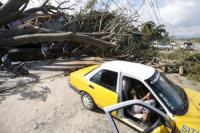-
Freezing in record lows may raise doubts about global warming

If you are shivering from unusually teeth-rattling cold this holiday season, global warming is probably the last thing on your mind. “The local weather conditions people experience likely play a role in what they think about the broader climate,” says one expert. “Climate change is causing record-breaking heat around the world, but the variability of the climate means that some places are still reaching record-breaking cold. If you’re living in a place where there’s been more record cold weather than record heat lately, you may doubt reports of climate change.”
-
-
Accelerating sea level rise requires collaborative response: Experts
Recent estimates suggest that global mean sea level rise could exceed two meters by 2100. The projections pose a challenge for scientists and policymakers alike, requiring far-reaching decisions about coastal policies to be made based on rapidly evolving projections with large, persistent uncertainties. Policymakers and scientists must thus act quickly and collaboratively to help coastal areas better prepare for rising sea levels globally, say climate change experts.
-
-
Most U.K. coastal flooding caused by moderate, not extreme storms
Scientists have found that the majority of instances of coastal flooding around the United Kingdom in the last 100 years have been due to moderate storm events combined with high spring tides, rather than extreme storms.
-
-
Climate engineering uncertainties limit its use in slowing climate change
Climate engineering refers to the systematic, large-scale modification of the environment using various climate intervention techniques. A new suggests that the uncertainties associated with climate engineering are too great for it to provide an alternative to the rapid reduction of greenhouse gas emissions.
-
-
Remote-control skillful rescue robot demonstrated
Researchers have developed a prototype construction robot for disaster relief situations. This prototype has drastically improved operability and mobility compared to conventional construction machines.
-
-
Seeking greater accuracy in predicting storm strength

Fully developed tropical cyclones — variously called hurricanes, typhoons or cyclones, depending on their region — can grow as wide as several hundred miles and sustain winds faster than 150 miles per hour. For example, Typhoon Tip (1979) had 190-mph winds and Hurricane Patricia (2015) whipped up 215-mph winds (the record). Such storms are notoriously difficult to predict, presenting a volatile meteorological cocktail that can change direction, speed, and strength, quickly and unexpectedly.
-
-
Helping shape safer coastal communities
Higher dunes can help protect communities from damaging waves and surge; they can also impede natural coastal processes. Scientists need better to understand how dunes’ effectiveness in protecting developed areas will be affected by long-term coastal change, or by extreme events such as hurricanes. Coastal zone research projects will fill in some of those knowledge gaps, heling managers protect developed areas’ beach dunes, which are vital to resilient communities, ecosystems, and economies.
-
-
Accelerating sea level rise threatens communities, infrastructure in NY, NJ, Conn.
Parts of the New York, New Jersey, and Connecticut metropolitan area are at risk of being permanently flooded by sea level rise. A new study details the severe threats posed to the region’s bay areas, coastal urban centers, beach communities, and airports and seaports by as little as one foot of sea level rise, a possibility as soon as the 2030s. Sea level rise already has begun to affect communities and critical infrastructure in the region, and presents tough decisions for vulnerable areas.
-
-
U.K. winter 2015-16 floods: One of the century’s most extreme and severe flood episodes
A new scientific review of the winter floods of 2015-2016 confirms that the event was one of the most extreme and severe hydrological events of the last century. The new hydrological appraisal brings together both river flow and meteorological data in an analysis of the events that led to extensive river flooding in northern England, Scotland, Northern Ireland, and parts of Wales over a three-month period.
-
-
Climate change likely caused deadly 2016 avalanche in Tibet
On 17 July, more than 70 million tons of ice broke off from the Aru glacier in the mountains of western Tibet and tumbled into a valley below, taking the lives of nine nomadic yak herders living there. With the deadly avalanche, it appears climate change may now be affecting a once stable region of the Tibetan Plateau, researchers have concluded, as two glaciers collapse within two months in once-stable region.
-
-
Warming-driven loss of soil carbon might equal U.S. emissions
For decades scientists have speculated that rising global temperatures might alter the ability of soils to store carbon, potentially releasing huge amounts of carbon into the atmosphere and triggering runaway climate change. Yet thousands of studies worldwide have produced mixed signals on whether this storage capacity will actually decrease — or even increase — as the planet warms. It turns out scientists might have been looking in the wrong places. A new study finds that warming will drive the loss of at least 55 trillion kilograms of carbon from the soil by mid-century, or about 17 percent more than the projected emissions due to human-related activities during that period. That would be roughly the equivalent of adding to the planet another industrialized country the size of the United States.
-
-
U.S. to face five-fold increase in extreme downpours across parts of the country
At century’s end, the number of summertime storms that produce extreme downpours could increase by more than 400 percent across parts of the United States — including sections of the Gulf Coast, Atlantic Coast, and the Southwest. The intensity of individual extreme rainfall events could increase by as much as 70 percent in some areas. That would mean that a storm that drops about 2 inches of rainfall today would be likely to drop nearly 3.5 inches in the future.
-
-
Climate change to drive stronger, smaller storms in U.S.
The effects of climate change will likely cause smaller but stronger storms in the United States, according to a new framework for modeling storm behavior. Though storm intensity is expected to increase over today’s levels, the predicted reduction in storm size may alleviate some fears of widespread severe flooding in the future. The new approach uses new statistical methods to identify and track storm features in both observational weather data and new high-resolution climate modeling simulations.
-
-
USGS, DoD partner in preparing for major natural disasters
In 2003, USGS partnered with the U.S. Department of Defense (DOD) - U.S. Northern Command (USNORTHCOM) to establish a liaison between the two organizations to facilitate science support in the event of a major natural disaster. The USGS liaison coordinates requests for science information and expertise, and general civil support and humanitarian assistance activities. This science support enables USNORTHCOM to perform critical national defense and civil support missions, as well as understand the impacts of natural disasters.
-
-
Is climate change responsible for increasing tornado outbreaks?
Tornadoes and severe thunderstorms kill people and damage property every year. Estimated U.S. insured losses due to severe thunderstorms in the first half of 2016 were $8.5 billion. The largest U.S. impacts of tornadoes result from tornado outbreaks, sequences of tornadoes that occur in close succession. New research shows that the average number of tornadoes during outbreaks—large-scale weather events that can last one to three days and span huge regions—has risen since 1954. But the researchers were not sure why.
-
More headlines
The long view
Strengthening School Violence Prevention
Violence by K-12 students is disturbingly common. Ensuring that schools have effective ways to identify and prevent such incidents is becoming increasingly important. Expanding intervention options and supporting K-12 school efforts in Behavioral Threat Assessment and Management (BTAM) would help.
Huge Areas May Face Possibly Fatal Heat Waves if Warming Continues
A new assessment warns that if Earth’s average temperature reaches 2 degrees C over the preindustrial average, widespread areas may become too hot during extreme heat events for many people to survive without artificial cooling.
Trump’s Cuts to Federal Wildfire Crews Could Have “Scary” Consequences
President Donald Trump’s moves to slash the federal workforce have gutted the ranks of wildland firefighters and support personnel, fire professionals warn, leaving communities to face deadly consequences when big blazes arrive this summer. States, tribes and fire chiefs are preparing for a fire season with minimal federal support.
